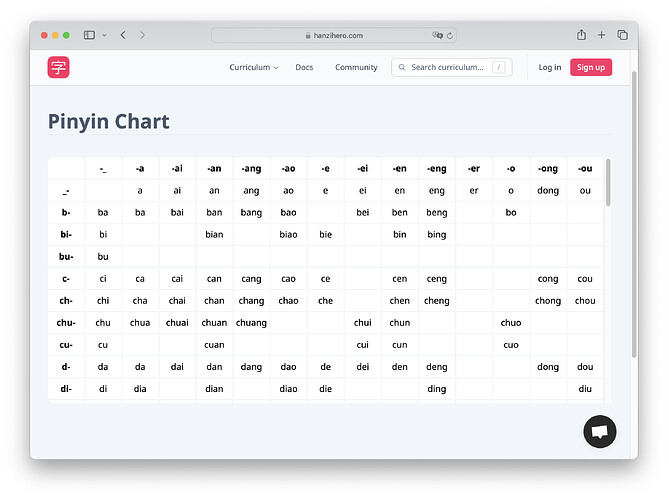New pinyin chart!
We’ve added a basic pinyin chart to make it easy for anyone to get an overview of the HanziHero pinyin system. It can be accessed at any time from the Curriculum dropdown within the web app.
We plan to expand it in the coming weeks with an FAQ about common pinyin quirks among other things.
New -ong final
As part of this update, we have also rolled out a change to add a new -ong final. We choose “temple” to represent this final, since the -ong sound is similar to the deep sound a gong would make, which are found in most temples. Clever, we know.
This makes HanziHero pinyin initials/finals a bit more similar to the set within standard pinyin.
Before this addition, e.g., gong was broken down as gu- + -eng. This quirk required some in-depth knowledge of how Zhuyin, Pinyin, and Chinese phonetics work to understand. It was inherited from the Marilyn method system that HanziHero was initially based off of. However, it is a common source of confusion for new users. Additionally, the lack of -ong final meant that e.g., xiong was represented as xu + eng which is even MORE confusing (even if this is indeed how it is conceptually represented in Zhuyin). ![]()
Instead, e.g., gong will now be broken down as g- + -ong. This is much easier to remember and understand. ![]()
Here is the full list of syllable changes as a result of this change:
dong = d- + -ongtong = t- + -ongnong = n- + -onglong = l- + -onggong = g- + -ongkong = k- + -onghong = h- + -ongzhong = zh- + -ongchong = ch- + -ongrong = r- + -ongzong = z- + -ongcong = c- + -ongsong = s- + -ongyong = y- + -ongjiong = ji- + -ongqiong = qi- + -ongxiong = xi- + -ong
Much better!
The mnemonics for all characters that now have an -ong final have all been changed as part of this update.
Upcoming changes to make sounds more clear
In the coming weeks we will be rolling out some smaller improvements to sounds. These include things like:
- Improving the pinyin chart with an FAQ.
- Showing example characters a given sound is in within lessons.
- Improving the sound subject page with additional relevant info.
- Making more clear that the
ein-eng/-enis sometimes not present in the complete syllable in some cases by marking it with parentheses. for examplemi + (e)ng = ming.
If you have any suggestions for how sounds in HanziHero can be made easier to understand for new learners, please let us know. Our aim is to make HanziHero a suitable resource for users of all levels, especially those who may not know much about pinyin.

